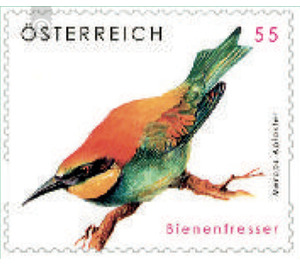animal welfare - Austria / II. Republic of Austria 2009 - 55 Euro Cent
Theme: Animals
| Country | Austria / II. Republic of Austria |
| Issue Date | 2009 |
| Face Value | 55.00 |
| Edition Issued | 650,000 |
| Printing Type | Photogravure |
| Stamp Type | Commemorative |
| Item Type | Stamp |
| Chronological Issue Number | 2156 |
| Chronological Chapter | OOS-OE2 |
| SID | 719312 |
| In 49 Wishlists | |
Hard to imagine: According to scientific studies, the honeybee genus has been around for about 100 million years. The oldest evidence is an amber fossil in the form of a three-millimeter primeval bee enclosed in a fossilized resin drop that was once discovered in a mine in northern Myanmar. The bee eater - he can reach a size of up to 28 centimeters - is one of the most colorful birds in Europe. Due to its striking plumage it is hardly to be confused: While the abdominal and chest area is turquoise, the crest, neck and back are rusty brown; the wings are held in both of these colors, and above the yellowish chin there is a black eye-streak. Also characteristic are the relatively long, slightly curved beak and the extended central control springs.


